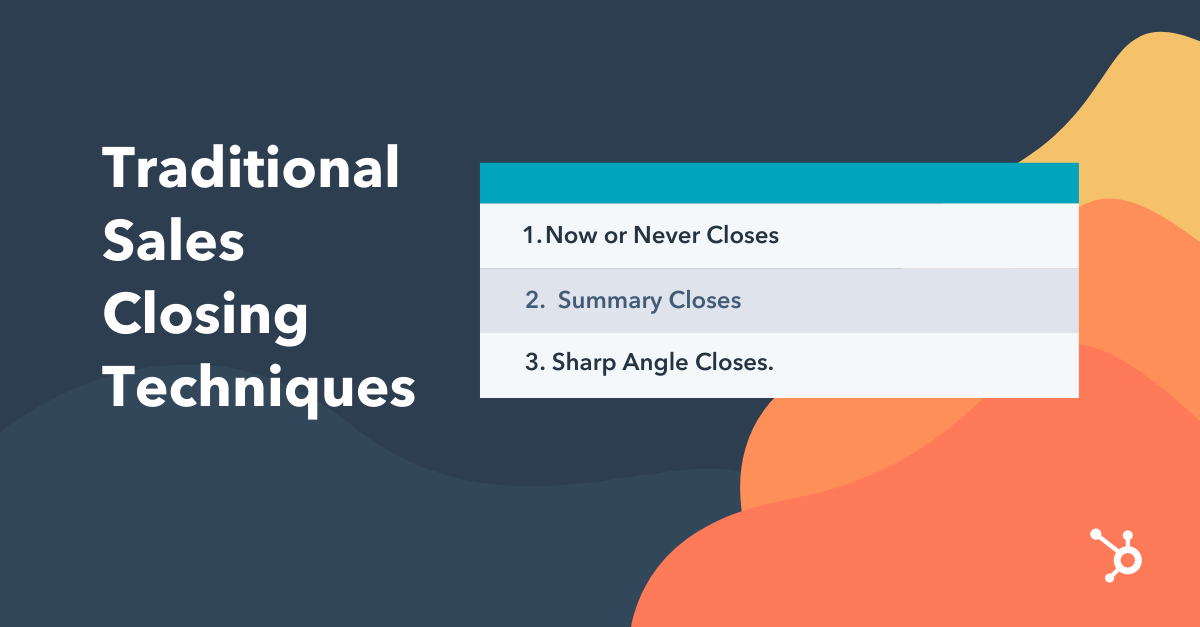Closing is a make-or-break moment in sales. Choosing the right phrases to seal a sales deal is crucial. And this moment is likely the final verdict determining whether or not your efforts will amount to anything at all.

You're not the only salesperson who feels apprehensive about the close. However, without that feeling of risk, successfully closing a sale wouldn't be so thrilling — which drives salespeople to continually strive for more.
Because sales professionals are expected to generate the best possible win rates for their effort, a large number of closing sales techniques have been developed over the years.
Here are a few proven closing techniques, and why they're so effective.
How to Close a Sale
- Now or Never Closes
- Summary Closes
- Sharp Angle Closes
- Question Closes
- Assumptive Closes
- Takeaway Closes
- Soft Closes
To close a sale with a prospect, there are many techniques you can employ. Here are a few of them:
Traditional Sales Closing Techniques
Traditional sales closing techniques usually employ some psychological tricks designed to give that final nudge. Here are two of the most common.
1. Now or Never Closes
This is where salespeople make an offer that includes a special benefit that prompts immediate purchase. For example:
- “This is the last one at this price.”
- "We’ve got a 20% discount just for customers who sign up today.”
- “If you commit to buy now, I can fast track you to the front of the implementation queue.”
This technique works because it creates a sense of urgency and can help overcome inertia when a prospect wants to buy — but for some reason isn't pulling the trigger. It's also a tried and true method for closing a sale over the phone because you have the person's undivided attention in real-time. Of course, you should always establish value before offering a discount or promotion.
2. Summary Closes
Salespeople who use this closing technique reiterate the items the customer is hopefully purchasing (stressing the value and benefits) in an effort to get the prospect to sign. For example:
“So we have the Centrifab washing machine with brushless motor, the 10-year comprehensive guarantee, and our free delivery and installation service. When would be a good time to deliver?”
By summarizing previously agreed-upon points into one impressive package, you're helping prospects visualize what they're truly getting out of the deal.
3. Sharp Angle Closes
Prospects often ask for price reductions or ad-ons because they know they have the upper hand — and they also know you expect it. If you have approval from your sales manager to do so, try the sharp angle close technique to catch these prospects by surprise.
When they ask, "Could you add on a few extra hours of onboarding at a discounted rate?" reply, "Sure. But if I do that for you, will you sign the contract today?" It's likely they won't be expecting this response — first, because you agreed to their request, and second, because you've proposed closing today.
Modern Sales Closing Techniques-png-1.png)
These canned closing techniques probably seem a little old-fashioned. Perhaps they strike you as a little too "salesy," particularly in light of the rise of inbound sales.
In particular, the idea of closing itself needs to encompass any and all incremental agreements you secure throughout a sales process —not just the moment of final purchase.
In a sales engagement, reps should endeavor to:
- Discover the customer’s needs
- Effectively communicate how specific products or services offer an affordable and satisfactory solution to those needs
If these two requirements are properly achieved, then there should be no barrier to closure. The closing question can be asked directly at that point.
Quick reminder:
Be sure to track all of the information you collect at this stage in afree CRM. The data might not seem immediately useful, but keeping track of objections from a prospect can help you organizationally improve and close more deals in the long run.
4. Question Closes
To achieve these two foundational goals, it's imperative that reps ask prospects probing questions. Effective salespeople focus on closing a sale as soon as a conversation with a prospect begins. Through a series of questions, they develop desire in the client and eliminate every objection to purchase.
One can even close the sale in the form of a question, which allows the rep to address outstanding objections while gaining a commitment at the same time.
For example: “In your opinion, does what I am offering solve your problem?”
The question allows you to discover whether the prospect is sold on your product while keeping the door open for further selling. If the answer is ‘no’ it remains their opinion (not yet the truth), thereby allowing you to continue to sell. If the answer is ‘yes,’ then signing on the dotted line is the next step.
Here's another question close: “Is there any reason why we can't proceed with the shipment?"
This question asks either for closure or more information as to why the customer isn’t quite convinced. It’s win-win.
5. Assumptive Closes
This closing technique draws on the power of positive thinking. If you believe, from the first piece of email outreach, you will close this deal, it can have an incredible effect on the rest of the sales process.
What's important here is to closely monitor your prospect's interest, engagement, and objections throughout. After a call or meeting, ask, "Did this presentation align with your expectations?" If you've just provided them with new information about your product or service, ask, "Does this sound like something that would be valuable to your company? Does this meet a specific need or pain point?"
By keeping your ear to the ground — and assuming good intent from the start — you'll bring an authority and direction to your sales process that wouldn't be there otherwise.
6. Take Away Closes
If you have kids, you've likely noticed if you take a toy away from them — they'll want it more than ever. Use this similar psychological practice on your prospects.
If they're balking on price, remove a feature or service and present the discounted offer to them. It's likely, they'll be thinking about the part you removed rather than the discounted price.
7. Soft Closes
The soft close is a way to show your prospect the benefit of your product and then ask a low-impact question to ascertain whether they'd be open to learning more.
For example, "If I could reduce widget maintenance by 25% and increase widget productivity by 15%, would you be interested in learning more?"
You've clearly stated the benefits without making any demands or sudden requests.
If the example above still seems too direct, you could ask, "If I told you I could reduce widget maintenance by 25% and increase widget productivity by 15%, would that align with your company goals?"
This removes their need to commit to you in the slightest, and gives you more time to learn about their business needs.
What To Do After Closing a Sale
Once you've closed the sale, it's time to celebrate! But don't forget to tie up any loose ends before you high-five your team. Here are a few pro-tips for what to do after closing the deal.
- Log the deal in your sales software — Trust us, your sales leaders will thank you for this. Logging your deal will help keep your team on target for forecasting and help keep your pipeline up to date.
- Provide an introduction to the next team — It's likely that closing the deal is just step one of the customer's journey with your business. From here, they may need to speak with customer success or support to get onboarded. Set up an e-introduction to the next person taking over so that the customer has a smooth transition into the next step in the process.
- Follow up with the customer in a few days — Simply checking in to see how your new customer is feeling about their purchase will go a long way in building trust and customer loyalty. If issues do arise, you can quickly step in and help or find someone on your team who can.
Seal The Deal With These Techniques
Being skilled at closing is arguably one of the most important techniques a salesperson can master. Find a mentor or fellow salesperson who excels at it to help you implement these best practices.
Editor's note: This post was originally published in October 2019 and has been updated for comprehensiveness.Sales Closing Techniques
.jpg)
.jpg)

